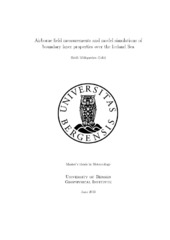Airborne Field Measurements and Model Simulations of Boundary Layer Properties over the Iceland Sea
Master thesis
Permanent lenke
https://hdl.handle.net/1956/20498Utgivelsesdato
2019-06-28Metadata
Vis full innførselSamlinger
- Master theses [122]
Sammendrag
The spatial and temporal distributions of a cold air outbreak (CAO) event over the Iceland- and southern Greenland Seas have been investigated during the IcelandGreenland Seas project (IGP) in February and March 2018. This area is arguably the least studied region of the North Atlantic sub-polar seas, and several observing platforms were therefore utilized in investigating the critical processes in the region. The focus of this study is on increasing the understanding of how the thermodynamic properties within the atmospheric boundary layer develop during a CAO. This is done by analysing observational data from a research aircraft and radiosondes. A distinct boundary layer deepening was observed over the marginal ice zone (MIZ), in the office direction, as the ocean transferred large amounts of heat and moisture to the atmosphere. In addition to providing in-situ measurements over the Iceland-Greenland Seas, the observational data are compared to the high-resolution regional COSMO_iso model in order to determine an optimal model setup for accurate simulations of the atmospheric water cycle. The accuracies of the model forecasts were observed to increase with decreasing lead time and finer resolution. A simulation with relatively long spin up time included large biases of surface temperature and humidity due to the development of an instability in the study area. These errors are reduced for the simulations with shorter spin-up time, at which a combination of fine resolution and 9-18 hours spin-up time is deemed optimal.
